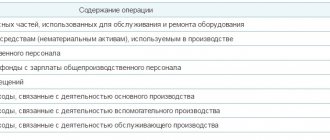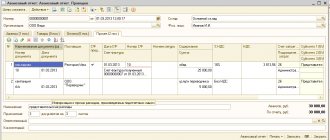Concept
Overhead costs are additional to the main expenses of the enterprise for the management, organization and maintenance of production. They are not directly related to the main production of goods or provision of services, and are not included in the cost of materials and labor.
Overhead costs thus - without being related to the main production process - ensure the normal functioning of the company or enterprise.
Overhead costs are included in the cost of goods, the costs of their production and circulation, but not directly , but indirectly - in proportion to the cost of materials and raw materials, the amount of wages, and so on.
As a result, estimated overhead costs can be called associated costs that are not directly transferred to the cost of each unit of production, but are subject to distribution.
Also see “Working with Overheads: Order for Approval.”
Administrative expenses
This type of overhead costs consists of costs for:
- remuneration taking into account the social contributions of the management apparatus, line personnel (heads of sections, foremen, etc.), persons providing services to the employees of the management apparatus;
- postal and telegraph costs;
- use of computers, computer equipment, which is listed on the organization’s balance sheet;
- topographical work (in the construction industry);
- payment for legal, information, consulting, auditing, notary and other services;
- purchase of office supplies;
- carrying out repairs;
- payment of travel allowances to employees;
- operation of a company car.
- depreciation charges for funds used by the management apparatus;
- entertainment expenses;
- payment for bank services.
This is an approximate list of costs. Each organization independently forms the structure of its management apparatus.
Composition of overhead costs
As a general rule, overhead costs include:
- Current repairs of buildings and structures, equipment.
- Salaries, training and maintenance of the administrative and managerial apparatus.
- Expenses for servicing vehicles on the company's balance sheet.
- Rent for office, product warehouse.
- Costs incurred due to downtime and defective products.
- Costs associated with the operation and maintenance of fixed assets.
- Costs of advertising, consulting services.
- Maintenance of the office, payment of utilities.
- Maintenance of main production.
- Expenses for communication services (telephone, Internet), etc.
Distribution of general business expenses. What are production overheads? The basis of their distribution.
Overhead costs can be more broadly grouped into four groups:
- Costs of production and its organization.
- Costs of maintaining the administrative apparatus.
- Staff service.
- Non-production expenses.
KEEP IN MIND
In the Tax Code of the Russian Federation, overhead costs are not designated as such, their structure is not defined. The same applies to accounting - there is no differentiation of overhead costs. Overhead costs are fixed by law only in such areas as construction, science, and medicine. Ordinary companies establish their own list of such costs.
For example, in trade organizations such expenses usually include costs associated with packaging, storage, transportation and marketing of products.
The amount of overhead costs is indicated in budget plans and estimates, as well as in the own budget plans of structural divisions.
Practice
I have already touched on the topic of inventory accounting in my article “Methods for estimating the cost of inventory in ODOO,” where the main methods for estimating the cost of inventory in ODOO were reviewed.
In this article, we will look at the main tools that ERP ODOO has for allocating overhead costs to inventory costs.
So, tool number 1 Landed Cost
If you translate this expression into Russian, you won’t immediately understand what it is for, but if you search on the Internet, you can find the following definition:
Landed cost – The total cost of a landed shipment including purchase price, freight, insurance, and other costs up to the port of destination. In some instances, it may also include the customs duties and other taxes levied on the shipment.
https://www.businessdictionary.com/definition/landed-cost.html
In Odoo, this is a standard tool that is available in the basic version, but in order for it to appear in the system, it must be activated. To do this, you must have the “Warehouse” module installed. Next, go to the general settings of the warehouse and put a tick in the “Cost with costs” field.
Save the settings and wait a couple of seconds. After these manipulations, we will have an additional menu item in the “Warehouse” application, which will be called “Cost with costs”
In order to let the system know that such and such expenses will need to be distributed, you need to make a mark in the “These are overhead expenses” field in the expense card, in the “Invoicing” tab, and select the default distribution method.
The following distribution methods are available:
- Equally
- In count
- At current price
- By weight
- By volume
To use this tool in the system, 2 conditions must be met:
- The inventory valuation method to which we allocate costs must be FIFO;
- Inventory valuation should be done automatically.
Read: Sales management in ERP ODOO
All these settings are made in the product category
If your company uses the “Weighted Average Cost” inventory valuation method, then you shouldn’t despair, but spend a little money, there are paid modules that cover this issue (for example, this one https://www.odoo.com/apps/modules/11.0/ dev_landed_cost_average_price/ )
Let's now move on to the tool itself.
In the “Date” field, indicate the date on which we want to carry out the operation in accounting.
In the “Movements” field we indicate the warehouse movements/stock lots to which we need to distribute costs
In the “Account Journal” field, indicate the accounting journal in which an entry about the distribution of expenses will be made.
In the cost lines we indicate Expense Items, distribution methods and the amount to be distributed.
Next, click the “Calculate” button
In the “Estimated adjustments” block you will see the distributed amounts according to the selected distribution base.
If everything is correct, after clicking on the “Check” button, a journal entry will be made in accounting, and the warehouse inventory balances will change their cost.
This tool can be used not only to increase costs, but also to record write-down transactions or revaluation of inventories and fixed assets in accounting. You just need to correctly indicate the accounting accounts to create a correct accounting entry.
Tool No. 2 “Distribution of expenses during procurement”
This tool is ideal for those companies that use the “Weighted Average Cost” to value inventory
After installing this module in Procurement, an additional menu item “Cost Allocation” will appear.
The first thing to do is to create lists of expenses that we plan to distribute, indicate for such expenses the default distribution method and the amount
After we have made the purchase of any stock and we need to distribute some expenses to its cost, go to the “Distribution of expenses” menu and create a new document “Distribution of expenses during purchase”
Read: Accounting for fixed assets and depreciation in ERP ODOO
Next, add purchasing items in the Pickings Line tab
And in the Expense tab we can either add expense items that need to be distributed manually or we can import expense items from supplier invoices
After adding all receipts and expense items, click the Calculate button and the system will calculate the new cost of the selected inventory. If everything is fine, after clicking the Update Cost button, the system will update the inventory cost.
If we pulled up the data of some supplier invoices, then in such invoices in the Landed Costs tab a link to the distribution document will appear.
The disadvantage of such a tool is that it does not create any records in accounting for changes in cost, but the warehouse cost itself changes. And the accountant will have to make such an entry in accounting manually.
Tool No. 3 Stock landed cost company percentage
This tool, when used at the time of a new purchase of goods, adds to the cost a certain percentage of the purchase cost on top.
But for this you need to do a number of actions.
- In the company settings, in the Landed Cost tab, select the accounting journal where the distribution record will be made;
- There you can select the types of expenses and indicate the percentage
Now, every time you make a purchase from a supplier, the percentage specified in the settings will be added to the cost of inventory and the Landed Cost document will be created, which we discussed above, and a corresponding entry will be made in accounting.
Results
We have looked at only a few tools that allow you to change the warehouse cost of inventory. Accounting for the cost of inventory is quite important for any company, and these tools allow you to control and change the cost depending on the needs of the company. But they must be used carefully and wisely.
Although we only considered the purchasing process, the first tool is quite flexible and can be used to change the cost of products that, for example, have gone out of production or to mark down inventories due to a deterioration in their quality or a change in expiration date.
How to calculate overhead costs
The company independently determines the parameters in proportion to which overhead costs will be distributed.
When planning overhead costs, several methods are usually used:
1. Determination of overhead costs in proportion to the wage fund of workers employed in the main production, as part of direct costs.
This method is suitable for organizations that have a significant number of primary production workers (primarily manual labor).
EXAMPLE
The company is engaged in cargo transportation. The wage fund is 10 million rubles. in year. In 2021, overhead costs, according to the plan, had a coefficient of 85% and, accordingly, amounted to 8.5 million rubles. That same year, the company reduced its workforce with the goal of reducing overhead costs by up to 60%.
Consequently, in 2021, while maintaining the payroll for workers in the main production, overhead costs will amount to 6 million rubles.
What is a BDD and methods of its formation. How is a time sheet filled out? What does the cost include:
2. If a company's production process is largely automated, it makes more sense to distribute costs in proportion to sales volume or machine hours.
3. If costs not directly related to production are significantly less than direct costs, it is logical to use the ratio of direct costs for the production of 1 unit of output to the total amount as the basis for distribution.
4. Overhead costs can be determined by direct counting for each of the available cost items.
5. In large organizations with a wide range of goods and complex infrastructure, combined methods for calculating overhead costs can be used.
EXAMPLE
The coefficient of general business overhead costs is distributed in proportion to the wage fund, and production costs - in proportion to material costs.
To plan and account for overhead costs, the total amount of costs for the business activities of the organization is calculated. Next, calculate the amount of overhead costs that will be included in the estimate for a unit of manufactured goods of each item.
If, according to the law, there is a planned cost, the amount of overhead costs is calculated in accordance with the standards established by law for specific expense items.
In general, overhead costs are calculated in accordance with the standards established in the company's accounting policies. They are calculated based on data from past periods, taking into account their planned changes.
In this case, the organization independently sets the period for making payments.
KEEP IN MIND
In tax accounting, some types of overhead costs are subject to rationing. And this:
- expenses for voluntary insurance of employees (clause 16, part 2, article 255 of the Tax Code of the Russian Federation);
- entertainment expenses (clause 2 of article 264 of the Tax Code of the Russian Federation);
- advertising expenses (clause 4 of article 264 of the Tax Code of the Russian Federation);
- expenses for the formation of reserves for warranty repairs and maintenance (Article 267 of the Tax Code of the Russian Federation);
- expenses in the form of interest on debt obligations under controlled transactions and controlled debt (Article 269 of the Tax Code of the Russian Federation);
- expenses for the formation of reserves for doubtful debts (paragraph 2, subparagraph 3, paragraph 4, article 266 of the Tax Code of the Russian Federation).
Read also
09.05.2020
Calculation procedure
Enterprises do not always understand how to calculate overhead costs; more precisely, the difficulties are largely due to the fact that it is impossible to immediately attribute them to a certain type of finished product or service. However, you cannot turn a blind eye to them, because this can cause the formation of an underestimated cost, which will ultimately negatively affect the amount of profit and profitability of production.
To correctly determine the amount of overhead costs when calculating costs per unit of production, the following methods of their distribution are used:
- proportional to the price of materials and raw materials used;
- in proportion to the remuneration of key workers;
- in proportion to revenue received, sales volume or other performance indicators.
There is no unified method. For example, if a company employs a large number of production workers, then it would be most logical to calculate overhead costs based on the wage fund. Only in this case will we be talking about the wages of production workers, excluding the wages of the management sector.
Example . The enterprise has 2 workshops: for the production of milk and cheese. In a month they produce 5,000 liters and 2,000 kg respectively. 150 and 200 thousand rubles are spent on paying workers, respectively. The cost must take into account overhead costs in the total amount of 100,000 rubles. How to distribute them? If we use the method of calculation proportional to wages, it turns out that overhead costs need to be distributed in the proportion of 150:200, that is, the cost of 1 liter of milk will include: (100,000 * 150/(150+250)/5,000) = 8, 57 rubles. And the cost of 1 kilogram of cheese: (100,000 * 200/(150+250)/2,000) = 28.57 rubles.
Some industries have their own overhead cost standards that businesses need to apply. For example, such exist in the chemical and mining industries, construction. The standards are established by the relevant regulations.
Similar articles
- What can be classified as indirect costs?
- Direct and indirect costs
- Production cost
- What is included in overhead costs in the estimate?
- Direct costs
Medicine
The cost of medical services is an assessment of the materials, operating systems, fuel, labor resources and other costs used in the process. According to purpose, costs are divided according to economic elements. Thus, the cost of services in government institutions includes labor costs with all deductions, travel expenses, food costs, purchase of medicines, and depreciation charges.
In addition, there is a division of costs into distribution costs, direct, general and overhead costs. These are costs that do not have a direct connection with individual types and are allocated to cost. These include, in particular, the costs of operating the operating system, production, employee training, etc. Direct costs are directly related to the provision of services. This is the salary of employees involved in providing the service, the cost of materials, food costs, etc. The institution also spends money on management, organizing processes and delivering services to consumers. These amounts form general economic and distribution costs.
The distribution of overhead costs can be carried out in proportion to direct costs, revenue volume, or another indicator. The last category in trading and manufacturing enterprises includes profit. But government institutions are created not to generate income, but to implement social objectives. Therefore, the results of the work of government agencies can be assessed by:
- The volume of quality services provided. The greater the volume of services provided, the more needs were met, and the more profit the medical institution received.
- Labor intensity of the service. It is expressed in the duration of the process of providing it, the involvement of a large number of employees, and the amount of materials. This also leads to a gap in the time of receipt of income. However, labor intensity, although indirectly, affects the overall result.
Now let’s look at examples of how overhead costs are divided into fixed and variable according to new indicators.




